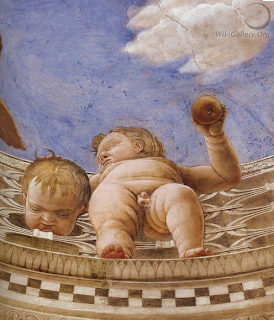Wallpaper design. The qualities in this design are how you can feel the cold winter day, wet and sluggish. The trees are dead and the street is flooded with melting snow. Charles Burchfield based his work off of life experiences and what he was surrounded by. He also loved viewing nature. Charles grew up in Ohio and he first wanted to be a nature writer but then transferred to the visual aspect.
Rembrandt Harmenszoon van Rijn
 The Three Crosses is an etch that was done by the dutch artist Rembrandt. the qualities in this etch is how complex it is, the shadows and light are so unique. You can see the emotions in the people crying, sad and shocked. What Rembrandt did was express feeling and emotion especially trying to relate it in spiritual ways. He lived in the 1600's when religion was a very important aspect of its time the church had a lot of power. So him being surrounded by religion he wanted to express what visual he had on the spiritual life or the past stories.
The Three Crosses is an etch that was done by the dutch artist Rembrandt. the qualities in this etch is how complex it is, the shadows and light are so unique. You can see the emotions in the people crying, sad and shocked. What Rembrandt did was express feeling and emotion especially trying to relate it in spiritual ways. He lived in the 1600's when religion was a very important aspect of its time the church had a lot of power. So him being surrounded by religion he wanted to express what visual he had on the spiritual life or the past stories. Jasper Johns
Three Flags. This interested me because how the flags have the old tradition stars of only 48 on them. Also it is unique because of how vivid the colors are. Jasper has had many works of art that are very patriotic like Three Flags, Flag and Map, they all represent America. Jasper lived during the Korean War which may be his influence to these pieces.
Jackson Pollock
 The qualities I see in Jackson's paintings are how the first layer is dark so the top layer when using different/ brighter colors it really shows the complexion. Jackson did experiments with liquid paint he discovered and called one technique as the "drip" technique. His work is described as "action painting". A major influence in Jackson's life was his wife, he dealt with alcoholism which led to his death in a car accident. Jackson liked to be different and get involved in his work in a different way then most artists, he wanted it to be different and special.
The qualities I see in Jackson's paintings are how the first layer is dark so the top layer when using different/ brighter colors it really shows the complexion. Jackson did experiments with liquid paint he discovered and called one technique as the "drip" technique. His work is described as "action painting". A major influence in Jackson's life was his wife, he dealt with alcoholism which led to his death in a car accident. Jackson liked to be different and get involved in his work in a different way then most artists, he wanted it to be different and special.Emil Nolde
 The qualities I see in Emil's watercolor paintings are how greatly detailed they are. Having to work with watercolors in the past I know personally it is not an easy task but Emil makes his artwork look wonderful without any flaws. Emil was very interested in flowers and many of his works are focused on flowers like this one here. He was very interested in Vincent Van Gogh's work as he was his inspiration. Emil lived during a dark time when WWII was occurring Hitler rejected his work in museums. Emil therefore loved using colors he once mentioned the colors make him happy inside and express many good feelings.
The qualities I see in Emil's watercolor paintings are how greatly detailed they are. Having to work with watercolors in the past I know personally it is not an easy task but Emil makes his artwork look wonderful without any flaws. Emil was very interested in flowers and many of his works are focused on flowers like this one here. He was very interested in Vincent Van Gogh's work as he was his inspiration. Emil lived during a dark time when WWII was occurring Hitler rejected his work in museums. Emil therefore loved using colors he once mentioned the colors make him happy inside and express many good feelings.Robert Rauschenberg
Robert makes his artwork unique by he makes his work "combined". He wanted the space between life and artwork to be defined and exposed. His concepts were consisted of combining the times and places into one, to show the importance of what he was trying to get across to the viewer.































